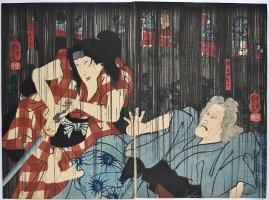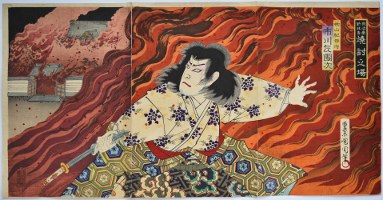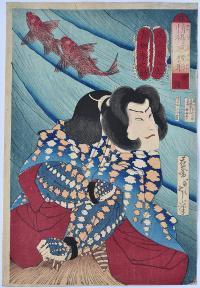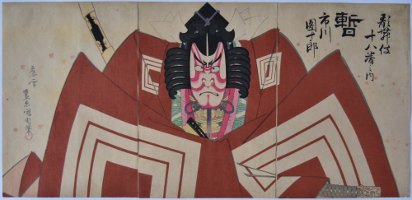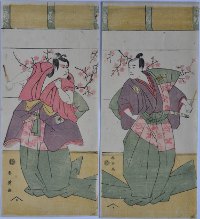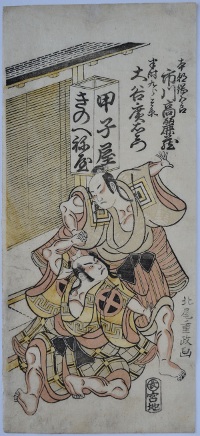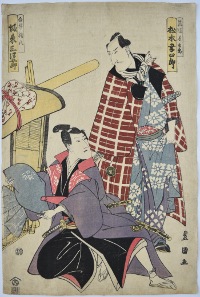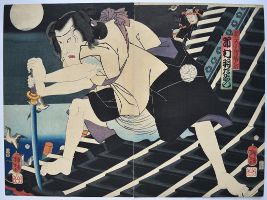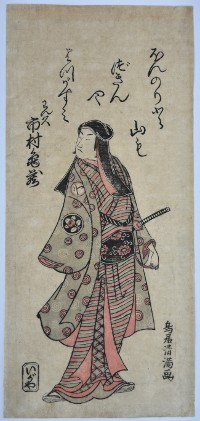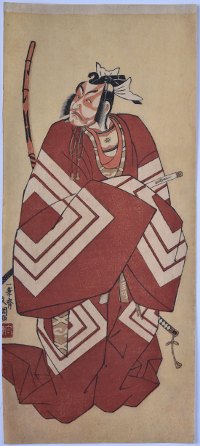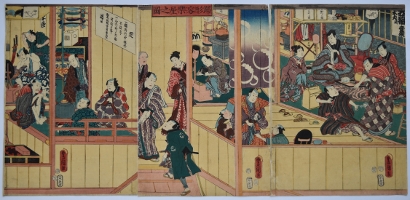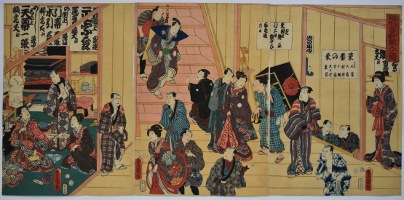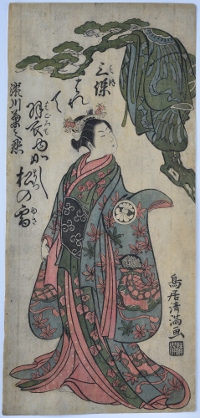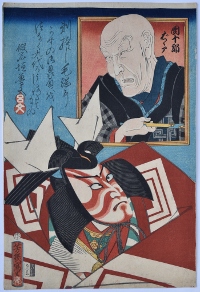Utagawa KUNISADA (1786-1864)

Click here to view image full size.
A vertical diptych showing the actor Onoe Baiko III in the role of the vengeful and disfigured spirit of Kasane above Sawamura Tossho I as her husband Kinoshitagawa Yoemon. From the play Kuruwa kruwa date no ooyose performed at the Ichimura-za theatre 1836. Published by Kawaguchiya Chozo, 1836. Extremely rare.
Fine impression and colour. Very good condition. Signed Gototei Kunisada ga.
Status: Sold
Toyohara KUNICHIKA (1835-1900)

Click here to view image full size.
A vertical triptych showing Onoe Kikugoro as Okiku’s ghost; Ichikawa Danjuro IX as the daimyo Aoyama Tessan, and Onoe Kikujiro V and Onoe Matsusuke V as his retainers in the play Sarayashi kesho no sugatami, “Mirror of the House of Blue Dishes.” Performed at the Kabuki-za Theatre, 10/1892. There are two versions of the story: In one, the mistress of the house breaks a valuable blue and white Dutch plate, hiding it in a well and blaming the maid-servant Okiku, who then commits suicide in the well. In the other, Okiku refuses to become Aoyama’s mistress who hides the plate and threatens to accuse her of theft. She throws herself into the well. But in both cases Okiku’s ghost comes back to haunt Aoyama. Published by Fukuda Kumajiro, 1892.
Very fine impression and colour. Very small nicks out of top margin, otherwise fine condition. Full, untrimmed size. Signed Toyohara Kunichika hitsu.
Status: Sold
Utagawa KUNISADA (1786-1864)
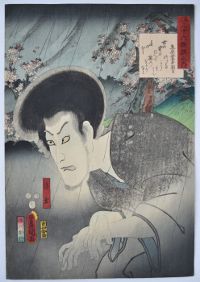
Click here to view image full size.
The actor Danjuro VIII as the ghost of Seigen from a set of prints Mitate sanjurokkasen no uchi, “An Imaginary Thirty-six Poets” published by Iseya Kanekichi in 1852. The relevant poet in this case is Ariwara no Narihira. The corrupt priest Seigen broke his vows of chastity when he fell in love with Sakurahime. Danjuro played this role in the play Yami no ume yume no tamakura, in the New Year’s programme at the Kawarazaki theatre, Edo, in 1/1853.
Very fine early impression with glue applied to the eyes. Fine colour and condition. Signed Toyokuni ga.
Status: Sold
Utagawa KUNIYOSHI (1797-1861)
Click here to view image full size.
A diptych showing the actors Bando Shuka (left) as O-kaji, wife of Danshichi, with sword drawn attacking Seki Sanjuro III as the old hag, wife of Giheiji of Mikawa-cho in pouring rain. From the play Shinzo Tsurifune kidan performed at the Ichimura theatre, 5/1852. Published by Kakumotoya Kinjiro. Kuniyoshi designed another version of this play in the same year for another publisher.
Fine impression and colour. Very good condition. Signed Ichiyusai Kuniyoshi ga.
Status: Sold
Utagawa KUNICHIKA (1835-1900)
Click here to view image full size.
A triptych showing the actor Ichikawa Sandanji I as Akiyama Kiimori amidst an intense conflagration started in an attempt to capture him, Yakuchi no ba. From the series Meiijiza shinkyogen, “New Plays from the Meiji Theatre.” Published by Akiyama Buemon , 1894.
Fine impression, colour and condition. The sheets joined. Signed Toyohara Kunichika hitsu.
Status: Sold
Taiso YOSHITOSHI (1839-1892)
Click here to view image full size.
The actor Onoe Kikugoro V as Aoyagi Harunosuke from a fine and rare set of 14 actor prints: Seiu kandankei, “A Barometer of Emotions.” This being Full Tide. The set published by Okura Magobei, 1877. Presumably showing Kikugoro in the play Shianui Monogatari written by Ryukatei Tanekazu; Ryutei Tanehiko II; and Ryusuitei Tanekiyo. The actor was a great friend of Yoshitoshi.
Very good impression and colour. Slight soil and creasing, otherwise good condition. Signed Oju Yoshitoshi hitsu.
Status: Sold
Toyohara KUNICHIKA (1835-1900)
Click here to view image full size.
A full-on image of the actor Ichikawa Danjuro IX as Kamakura Gongoro Kagemasa in the Shibaraku play with the voluminous costume associated with the role. Title: Kabuki juhachiban no uchi/Shibaraku, “The Eighteen Famous Kabuki Plays:Shibaraku.” Kunichika made a number of prints, single, diptych and triptych, of this subject but this particular design is rare. Published by Mizuno Asajiro, c. 1895.
Very good impression and colour. Background partly blind-printed. Slight trimming losing publishing information on left edge of last sheet and slight soil. Otherwise good condition. Signed Oju Toyohara Kunichika hitsu.
Status: Sold
Katsukawa SHUN’EI (1762-1819)
Click here to view image full size.
A hosoban diptych complete showing Ichikawa Monnosuke II ( left sheet ) as Soga no Goro and Sawamura Sojuro III ( right sheet ) as Soga no Juro in the play Shunshoku Edo-e Soga performed at the Ichimura-ya in the first month of 1791. Published by Harimaya Shinshichi. Most hosoban multiples have become separated over time.
Very good impression, colour and condition. Completely untrimmed. Signed Shun’ei ga.
Status: Sold
Tsukioka YOSHITOSHI (1839-1892)
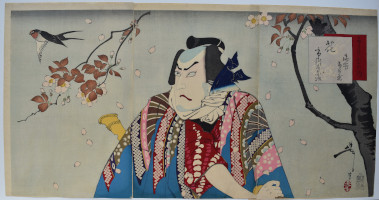
Click here to view image full size.
Hana, “Flowers” from the set Setsugekka no uchi, “Snow, Moon, and Flowers.” Shows the actor Ichikawa Sadanji as Gosho no Gorozo. The main character in the play Soga moyo tateshi no goshozome, “The Story of Gorozo, the Chivalrous Commoner.” A convoluted plot (as usual) with the samurai Gorozu becoming an otokodate upon being expelled by his family because of an undesirable love affair. Gorozu ends up killing his old master’s lover, Oshu. Published by Akiyama Buemon, 1890. A fine set of bust portraits.
Fine impression, colour and condition. Signed Yoshitoshi.
Status: Sold
Utagawa TOYOKUNI I (1769-1821)
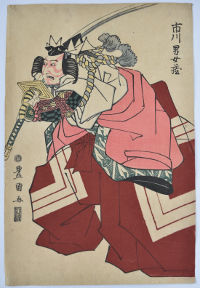
Click here to view image full size.
The actor Ichikawa Omezo I in the role of Hannya no Goro in a Shibaraku scene. Part of the play Monomiguruma yuki no takadono performed at the Morita-za Theatre, 11/1810. Published by Kawachiya Genshichi. A striking design.
Fine impression and colour. Small expertly repaired binding holes at top, otherwise fine condition. Full size. Signed Toyokuni ga.
Status: Sold
Katsukawa SHUNKO (1743-1812)
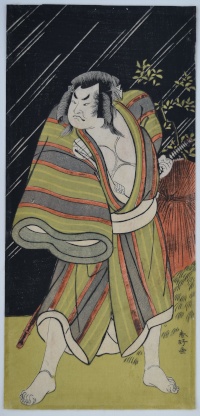
Click here to view image full size.
An hosoban showing the actor Sakata Hangoro II as the sumo wrestler Kujaku Saburo Narihira in pouring rain in the kaomise drama Sugata no hana yuki no kuronushi performed at the Ichimuraza Theatre, 11/1776. Shunko was a pupil of Katsukawa Shunsho and is thought to have originated the okubi-e format. Another impression is in AIC, 1939.881 (ex Frederick W. Gookin collection).
Fine impression, colour and condition. Signed Shunko ga.
Status: Sold
Kitao SHIGEMASA (1739-1820)
Click here to view image full size.
A hosoban showing the actors Ichikawa Komazo II (above right) in the role of Honcho Tsunagoro and Otani Hiroemon II (below) as Hantoki Kuroemon. The play was the second item (nibanme) on the programme which came after the first play Hatsuakinai omise Soga performed at the Nakamura-za Theatre, Spring 1767. The shop sign behind the actors reads Kinoeneya. Published by Miyaji, 1767.
Fine impression. Slight fading, otherwise very good colour and condition. Signed Kitao Shigemasa ga.
Status: Sold
Utagawa KUNISADA (1786-1865)
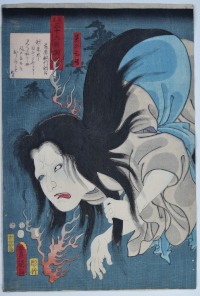
Click here to view image full size.
The actor Ichikawa Kodanji IV as the ghost of Kasane from a set Mitate sanjurokkasen no uchi, “An Imaginary Thirty-six Poets.” A famous early compilation; in this case the image is inspired by a poem of Fujiwara no Toshiyuki Ason. Shows Kasane’s vengeful ghost appearing to her husband who had murdered her. Published by Iseya Kanekichi, 1852.
Very fine early impression showing overall strong woodgrain and glue applied to the ghost’s right eye. Fine colour. Very small binding holes, otherwise very good condition. Signed Toyokuni ga.
Status: Sold
Utagawa KUNISADA (1786-1865)
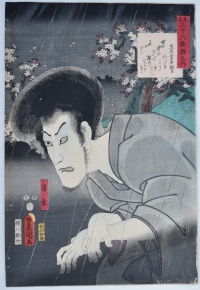
Click here to view image full size.
The actor Ichikawa Danjuro VIII as the ghost of Seigen from a set Mitate sanjurokkasen no uchi, “An Imaginary Thirty-six Poets.” A famous early compilation; in this case the image is inspired by a poem of Ariwara no Narihira.The ghost is of the depraved priest Seigen who broke his vows of chastity by falling in love with Sakurahime (Princess Cherry Blossom), hence the cherry trees behind Seigen. He is expelled from the monastery and starves to death. Published by Iseya Kanekichi, 1852.
Very fine early impression with glue applied to the ghost’s eyes. Fine colour. Very small binding holes, otherwise very good condition. Signed Toyokuni ga.
Status: Sold
Utagawa KUNISADA II (1823-1880)
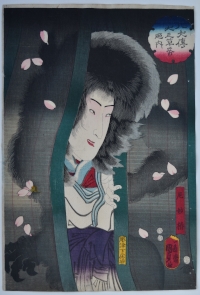
Click here to view image full size.
The actor Segawa Kikunojo V as the Cat Witch Ama Myochin from the set Hakkenden inu no soshi no uchi , “Stories of the Eight Dog Heroes.” Published by Tsutaya Kichizo, 1852. The extremely lengthy novel by Kyokutei Bakin took 30 years to complete and was turned into a very successful play which was premiered at the Ichimura-za Theatre, 1/1852. The convoluted story tells of the supernatural offspring from the coupling of Princess Fuse and her father’s dog Yatsufusa. They are later reborn to normal mothers and the plot revolves around their gradual discovery of each other. Shows the cat’s human form appearing through a bamboo curtain while her true self, with claws and hairy arms, can be seen silhouetted behind the curtain. She murders the father of the dog hero Inamura Kakutaro and then assumes his likeness. The best design from a fine set.
Very fine impression with burnishing and blind-printing. (The finest impression I have seen.) Fine colour. Small binding holes, otherwise fine condition. Full size. Signed Ichiyosai Kunisada ga.
Status: Sold
Utagawa KUNISADA II (1823-1880)
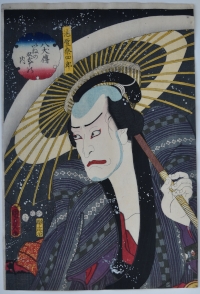
Click here to view image full size.
The actor Nakamura Tsuruzo I as Awayuki Nashito, a vassal of the daimyo Takeda Nobumasa, from the set Hakkenden inu no soshi no uchi , “Stories of the Eight Dog Heroes.” Published by Tsutaya Kichizo, 1852. The extremely lengthy novel by Kyokutei Bakin took 30 years to complete and was turned into a very successful play which was premiered at the Ichimura-za Theatre, 1/1852. The convoluted story tells of the supernatural offspring from the coupling of Princess Fuse and her father’s dog Yatsufusa. They are later reborn to normal mothers and the plot revolves around their gradual discovery of each other. A fine set.
Very fine impression with burnishing and extensive splashed gofun simulating snow. Later printings omit the gofun and have flakes cut into the block. Fine colour. Small binding holes, otherwise fine condition. Full size. Signed Kunisada ga.
Status: Sold
Utagawa KUNISADA II (1823-1880)
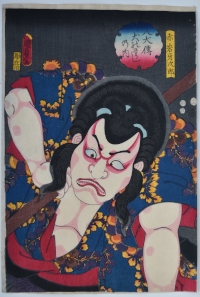
Click here to view image full size.
The Actor Bando Mitsuemon I as Akaiwa Gajiro from the set Hakkenden inu no soshi no uchi , “Stories of the Eight Dog Heroes.” Published by Tsutaya Kichizo, 1852. The extremely lengthy novel by Kyokutei Bakin took 30 years to complete and was turned into a very successful play which was premiered at the Ichimura-za Theatre, 1/1852. The convoluted story tells of the supernatural offspring from the coupling of Princess Fuse and her father’s dog Yatsufusa. They are later reborn to normal mothers and the plot revolves around their gradual discovery of each other. A fine set.
Very fine impression with extensive burnishing. Later printings omit the burnishing on the costume and replace it with bokashi. Fine colour. Small binding holes, otherwise fine condition. Full size. Signed Kunisada ga.
Status: Sold
Utagawa KUNISADA II (1823-1880)
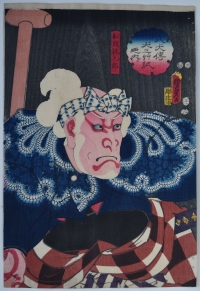
Click here to view image full size.
The actor Kataoka Ichizo I as the boatman Kajikuro from the set Hakkenden inu no soshi no uchi , “Stories of the Eight Dog Heroes.” Published by Tsutaya Kichizo, 1852. The extremely lengthy novel by Kyokutei Bakin took 30 years to complete and was turned into a very successful play which was premiered at the Ichimura-za Theatre, 1/1852. The convoluted story tells of the supernatural offspring from the coupling of Princess Fuse and her father’s dog Yatsufusa. They are later reborn to normal mothers and the plot revolves around their gradual discovery of each other. A fine set.
Extremely fine impression. Fine colour. Small binding holes, otherwise fine condition. Full size. Signed Kunisada ga.
Status: Sold
Utagawa KUNISADA II (1823-1880)
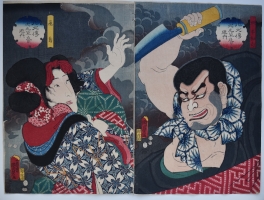
Click here to view image full size.
The complete diptych showing on the right the actor Arashi Otohachi III as the evil priest Bungyu attacking Asuka played by Fujikawa Kayu III from the set Hakkenden inu no soshi no uchi , “Stories of the Eight Dog Heroes.” Published by Tsutaya Kichizo, 1852. The extremely lengthy novel by Kyokutei Bakin took 30 years to complete and was turned into a very successful play which was premiered at the Ichimura-za Theatre, 1/1852. The convoluted story tells of the supernatural offspring from the coupling of Princess Fuse and her father’s dog Yatsufusa. They are later reborn to normal mothers and the plot revolves around their gradual discovery of each other. A fine set.
Extremely fine impressions. Fine colour. Small binding holes, otherwise fine condition. Full size. Signed Kunisada ga and Ichiyosai Kunisada ga.
Status: Sold
Ryusai SHIGEHARU (1803-1853)

Click here to view image full size.
The actor Nakamura Utaemon III as the ghost of Taira no Tomomori in the play Yoshitsune senbon zakura, “Yoshitsune and the Thousand Cherry Trees.” Famous for tying himself to an anchor and jumping into the sea at the battle of Dan-no-Ura (1185). Performed at the Kado Theatre, 5/1831. An Osaka print published by Wataya Kihei.
Fine impression and colour. Very good condition. Signed Gyokuryutei Shigeharu ga.
Status: Sold
Utagawa NOBUKATSU (Active 1824-1841)
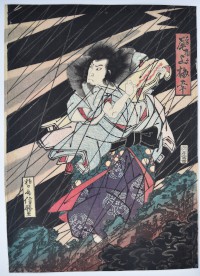
Click here to view image full size.
An Osaka print showing the actor Onoe Baiko III as Kan Shojo (Sugawara Michizane) in the play Sugawara denju tenarai kagami, “Sugawara and the Secrets of Calligraphy.” Performed at the Takeda Theatre, 3/1830. This is the famous Mt. Tempai scene from the play. Published by Tenmaya Kihei. Shows Kan Shojo transformed into the Thunder God wreaking revenge on his enemies.
Fine impression and colour. Crease near right edge, otherwise very good condition. Signed Tessai Nobukatsu ga.
Status: Sold
Utagawa TOYOKUNI (1769-1825)
Click here to view image full size.
An actor portrait showing Matsumoto Koshiro V (standing) in the role of Banzui Chobei and Bando Mitsugoro III as Shira Gonpachi next to a kago in Sakurada Jisuke I’s play Banzuin Chobei shojin manaita. Performed at the Nakamura-za 7/8/1803. Published by Nishimuraya Yohachi.
Very good impression and condition. Grey ground. Almost perfect colour. Signed Toyokuni ga.
Status: Sold
Torii KIYOMITSU (1735-1785)
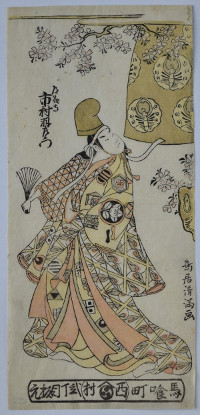
Click here to view image full size.
An hosoban showing the actor Ichimura Uzaemon IX in the role of Hanako performing the famous dance in Musume Dojoji, “The Maiden at Dojoji Temple.” Hanako is allowed to dance before the new bell at the temple only to reveal herself as the spirit of Kiyohime who killed the priest Anchin hidden beneath the first bell. Published by Nishimuraya Yohachi c 1765.
Fine impression. Very good colour and condition. Signed Torii Kiyomitsu ga.
Status: Sold
Katsukawa SHUNSHO (1726-1792)
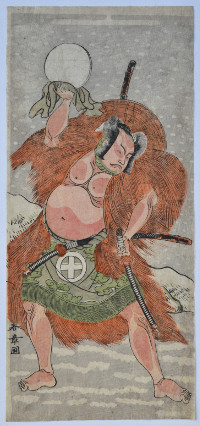
Click here to view image full size.
An hosoban showing the actor Otani Hiroji III wearing a red straw cape in the snow and holding aloft a crystal ball. An unidentified role published c. 1775. Evidently Hiroji was very popular with female theatre-goers.
Very good impression and colour. Minor soil and wear, otherwise very good condition. Signed Shunsho ga.
Status: Sold
Utagawa KUNISADA (1786-1864)
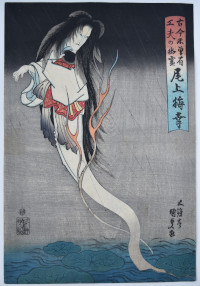
Click here to view image full size.
Onoe Baiko III (Kikugoro III) as the vengeful ghost of Kasane appearing to haunt her husband Yagoro who had murdered her after getting tired of her ugliness. From the play Kuruwa kuruwa date no oyose performed at the Ichimura Theatre 2/1836. Title: Kokon misou kufu no yurei, “Famous Ghosts of the Past and Present.”
Very fine impression. Fine colour. Slight centre fold, otherwise fine condition. Signed Gototei Kunisada ga.
Status: Sold
Utagawa TOYOKUNI I (1769-1825)

Click here to view image full size.
Shows the actor Onoe Shoroku I as Osakabehime, Princess Osakabe, a phantom who haunted the battlements of Himeji Castle. The character appeared in the play Matazoro Shoroku Osakabe banashi performed at the Ichimura-za Theatre from 22/5/1814. But this is probably a shini-e published the following year as it bears the information that Shoroku was 71 when he died (10/1815). Shoroku was renowned for his ghost roles. Published by Yamaguchiya Tobei who also published an impressive Kunisada vertical diptych of the same subject in 1814.
Very good impression, colour and condition. Signed Toyokuni ga.
Status: Sold
Utagawa KUNISADA (1786-1864)
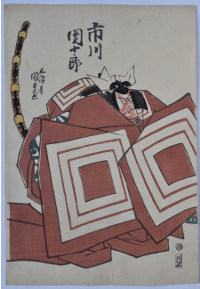
Click here to view image full size.
The actor Ichikawa Danjuro VII in the drama Shibaraku. He is seen in his voluminous robe with the large Sansho (three square) motif which was the symbol of the Danjuro acting clan. The origins of the drama go back to Danjuro I in 1697 although there have been changes over the centuries. It is not a play as such but a scene which lasts about 50 minutes and is inserted during interludes. Evidently Shibaraku, which translates as “Wait a minute” or “Stop a moment,” was first dramatically shouted by Danjuri I when his fellow thespians forgot or refused his cue to enter and take to the hanamichi, “flower path” set at right angles to the stage. It became so popular that it was included in the kaomise, “face-showing” performances every year. Published by Kawaguchiya Shozo, c. 1830.
Very good impression, colour and condition. Signed Gototei Kunisada ga.
Status: Sold
Torii KIYOMITSU (1735-1785)
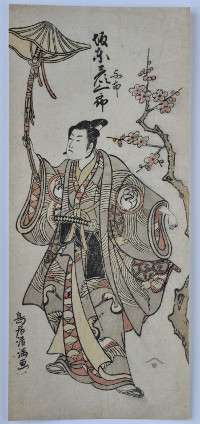
Click here to view image full size.
An hosoban benizuri-e showing the actor Bando Hikosaburo II as Sanada no Yoichi Yoshitada in the play Ume ya suisen izu no irifune performed at the Morita Theatre, 11/1763. Yoshitada served the Minamoto Clan and is usually shown fighting his adversary Matano Goro Kagehisa. Published by Harimaya Shinshichi. Interestingly, the impression in the MFA, Boston, 06.404, has the publisher’s seal Nishinomiya Shinroku. Possibly a slightly later reprint. Kiyomitsu was the second son of Kiyomasu II.
Very good impression and colour. Light album backing, otherwise very good condition. Signed Torii Kiyomitsu ga.
Status: Sold
Torii KIYOMITSU (1735-1785)
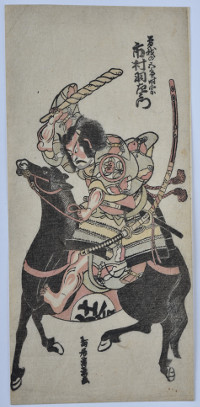
Click here to view image full size.
An hosoban benizuri-e showing the actor Ichimura Uzaemon IX as Soga no Goro Tokimune, brandishing a club, and riding to avenge the murder of his father by Kudo Suketsune. Published c. 1768. (The publisher’s seal may be on the underside of the horse.) Kiyomitsu was the second son of Kiyomasu II.
Very good impression and colour. Light album backing, otherwise very good condition. Signed Torii Kiyomitsu ga.
Status: Sold
Utagawa KUNIYOSHI (1797-1861)
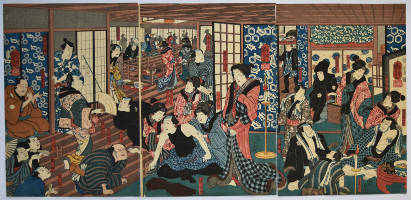
Click here to view image full size.
An interesting and rare Kuniyoshi triptych showing actors relaxing in a busy teahouse. In fact this group appeared in the play Sumidagawa tsui no kagamon performed at the Ichimura-za Theatre from the 3/3/1852. Left sheet: Suzuki Mondo just stepping into the room dressed in a blue and white yukata played by Sawamura Chojuro V. Other actors are Nakamura Kanemon , Nakamura Kantaro and Arashi Jitohachi III. Centre sheet: The courtesan Shiraito of the Hashimoto-ya standing right played by Bando Shuka I. Another actor Nakamura Kamenojo. Right sheet: The thug Tsukubane Sanpei seated holding a cup played by Otani Tomoemon IV and Oyaso, Mondo’s wife, seated by an hibachi played by Onoe Kikujiro II. Another actor being Bando Matataro. Published by Yamaguchiya Tobei, 1852.
Very good impression, colour and condition. Signed Ichiyusai Kuniyoshi ga.
Status: Sold
Tsukioka YOSHITOSHI (1839-1892)
Click here to view image full size.
A complete diptych showing the huge figure of the actor Ichimura Uzaemon XIII as Kozo Kikunosuke , a young thief, fighting the police on the roof of the Gokuraku-ji Temple. This is the culmination and Act V of the play Benten Kozo performed at the Ichimura-za Theatre, March 1862. Published by Shobundo, 3/1862. Rare: not listed in Keyes.
Fine impression and colour. Very lightly backed, otherwise fine condition. Signed Ikkaisai Yoshitoshi ga.
Status: Sold
Torii KIYOMITSU (1735-1785)
Click here to view image full size.
Shows the standing figure of the kabuki actor Ichimura Kamezo I as Wankyu in the play Furiwakamura suehiro Genji which according to the Museum of Fine Arts, Boston, which has another impression (no.21.8149), was staged at the Ichimura theatre, 11th month, 1760. But I have been unable to verify this. Certainly the date fits as Kamezo became Ichimura Uzayemon IX in 1762. Benizuri-e and a pale blue-grey. Published by Igaya Kan’emon.
Very good impression and colour. Very slight surface soil, otherwise very good condition. Signed Torii Kiyomitsu ga.
Status: Sold
Torii KIYONAGA (1752-1815)
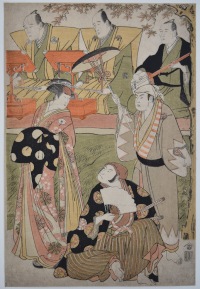
Click here to view image full size.
A fine actor design from a series of at least 31 such degatari prints (showing singing or chanting at a theatre). A scene from Shosa Hatsuhige yakko tanzen, played at the Ichimura-za theatre November 1783. Shows Nakamura Nakazo as Tanzen seated with a fan looking at Onoe Matsusuke as a young lady (in reality a white fox). To the right Ichimura Uzaemon as a yakko. The chanters Tomimoto Buzen-dayu and Tomimoto Itsuki-dayu at the back accompanied by Namizaki Tokuji. Published by Nishimura, 1783. See Hirano, Kyonaga, Museum of Fine Arts, Boston, no. 544, pl. LXXX.
Very good impression and colour. Slight edge soil, otherwise very good condition. Signed Kiyonaga ga.
Status: Sold
Ippitsusai BUNCHO (1763-1840)
Click here to view image full size.
Ichikawa Danjuro V probably as Watanabe Kiou Takiguchi in the play Nue no mori ichiyou no matsu performed at the Nakamura-za in the 11th month of 1770. It was in this month that Koshiro III took the name of Danjuro V. Shows Danjuro in the iconic costume of the Shibaraku scene with the giant mon. Buncho was a connoisseur of paintings ( he wrote Buncho gadan [ Treatise on Painting ] ), and was one of the most important painters and print designers of this period. A fine design and extremely rare.
Fine impression. The background probably “turned” from a pale blue ( as usual ). Trimmed into signature at left, otherwise very good condition. Signed Ippitsusai Buncho ga.
Status: Sold
Utagawa KUNISADA (1786-1865)
#
A rare 6-sheet design: Odori keiyo gakuya no zu, Odori keiyo nikai-iri no zu, “View of the Backstage and Dressing Rooms, Backstage at a Newly Opened Theatre.” The 1855 earthquake and resulting fire destroyed the Edo theatre district. Only five months later the first theatre – the Ichimura Theatre – was reopened. This print, issued the previous month, was an advertisement for the opening. A number of actors are recognisable by their mons. Published by Izumiya Ichibei, 1856, 2nd month.
Very good impression and colour. Some trimming, otherwise very good condition. This design is invariably trimmed as the designs that have survived are from albums where the top triptych had to fold down into the album. Signed Toyokuni ga.
Status: Sold
MANGETSUDO (Active 1743-1747)
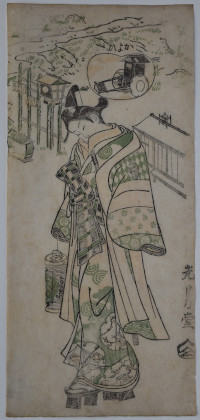
Click here to view image full size.
An hosoban showing a youth impersonated by Onoe Kikugoro I standing outside the Yoshiwara. Above is a cartouche showing a gosho-guruma (a mid-17th century Imperial cart) and above the cartouche the word Kayoi: An allusion to the story of Shosho visiting Komachi. This is the right sheet of a triptych with title Yoshiwara Komachi sambukutsui, “Komachi of the Yoshiwara, Set of Three.” (See Hayashi catalogue, 1902, no. 325 for the complete triptych.) Another impression is illustrated in The Clarence Buckingham Collection Of Japanese Prints, The Primitives, AIC, p. 183, which lacks signature and publisher’s seal. Published by Okumuraya, c 1740. Nothing is known about Mangetsudo, other than he was a follower of Masanobu.
Very good impression. Some fading, otherwise good condition. Signed Mangetsudo.
Status: Sold
Katsukawa SHUNKO (1743-1812)
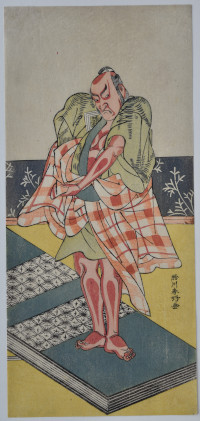
Click here to view image full size.
An hosoban showing the actor Ichikawa Danzo IV in the role of Tsuribune Sabu in the play Natsu matsuri kagami performed at the Morita-za Theatre, 7/1779.
Fine impression, colour and condition. Exceptional state of preservation. Signed Katsukawa Shunko ga.
Status: Sold
Utagawa YOSHITORA (Active c. 1850-1880)
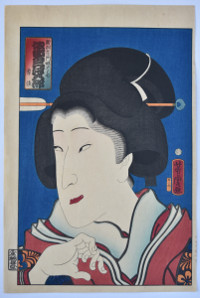
Click here to view image full size.
The actor Bando Mitsuguro V as Yushide, a daughter of Shindo Saemon from the play Karukaya doshin tsukushi no iezuto. From an untitled set of prints designed in conjunction with Kunisada. It was intended to represent the culmination of Kunisada’s career using only the finest materials, engravers and printers. Published by Kinshodo between 1860-1864. 150 designs were envisioned but only 72 were published, with 12 being by Yoshitora who joined the project in 1862. The plot concerns the machinations of rival Daimyo to possess a rare gem stone. Yushide is caught up in the shenanigans, the outcome being that she stabs herself in the throat with the white arrow she wears as a hair pin.
Superb impression. Fine colour and condition. Signed Yoshitora ga.
Status: Sold
Torii KIYOMITSU (1735-1785)
Click here to view image full size.
The actor Segawa Kikunojo II as the Tennin (a devine being that is able to fly by means of a feathered kimono) from the play Hagoromo, “The Feathered Mantle.” She stands on Miho Beach, the feathered kimono caught in the tree behind her. The story relates how fishermen find the boa but will only return it if she performs a dance. Published c early 1760s.
Fine impression. Very good colour: Benizuri-e with beni, green and blue. Some light toning and soil, otherwise very good condition. Signed Kiyomitsu ga with kiyomitsu seal.
Status: Sold
Utagawa YOSHIIKU (1833-1904)
Click here to view image full size.
An Ichikawa Danjuro memorial portrait showing Kawarazaki Gonjuro I (Danjuro IX, 1838-1903) in the Shibaraku role looking up at his father, Danjuro babaa (Ichikawa Danjuro VII [1791-1859]) who had died the previous year. It was some years before Gonjuro finally adopted the Danjuro name in 1874. Published by Ebisuya, 1860.
Fine impression, colour and condition. Signed Yoshiiku ga.
Status: Sold
